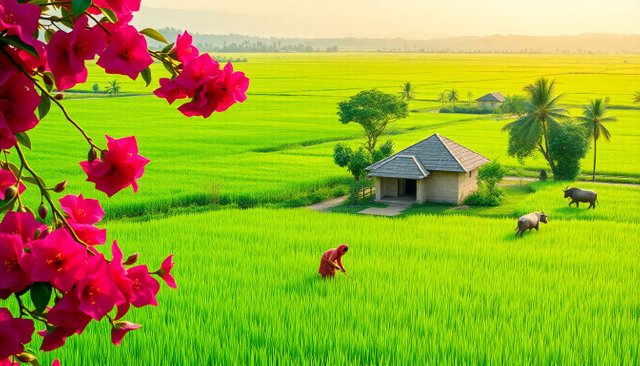Unveiling the Jewel of Bengal: Astonishing Facts About Bangladesh

Bangladesh, a land of vibrant colors and rich traditions, holds surprises at every turn. Did you know that it is home to the world's largest river delta? This unique land is more than just beautiful landscapes; it boasts a deeply woven history and diverse culture.
Situated in South Asia, Bangladesh shares borders with India to the west, north, and east, and Myanmar to the southeast. The Bay of Bengal lies to the south, offering stunning coastal views. Over the centuries, this region has been influenced by a medley of cultures due to its strategic location. From ancient kingdoms to colonial rule, Bangladesh's history is as rich as its culture.
This article explores the geography, economy, culture, and people of Bangladesh. Delve into the wonders of this nation, from its breathtaking natural features to its growing economy and vibrant cultural practices.
A Tapestry of Geography and Nature
Diverse Landscapes
Bangladesh is a land of contrasts. The Sundarbans, a UNESCO World Heritage site, is the largest mangrove forest in the world. It shelters the endangered Bengal tiger and a plethora of unique wildlife. Covering around 10,000 square kilometers, it’s just one example of Bangladesh's stunning landscapes.
River Systems and Waterways
The lifeblood of Bangladesh includes its extensive river systems—over 700 rivers flow across the country. The Ganges, Brahmaputra, and Meghna rivers nourish the land, supporting agriculture and transport. These rivers are essential for trade and culture, with the Ganges River being celebrated in many local festivals.
Climate and Environmental Concerns
Located in a low-lying region, Bangladesh faces threats from climate change. Rising sea levels endanger coastal communities, while frequent monsoon floods disrupt life. According to experts, about 20 million people could be displaced by 2050. Eco-friendly practices like afforestation and renewable energy are crucial for combating these issues.
The Economic Pulse of Bangladesh: Growth and Challenges
Economic Overview
Bangladesh's economy is thriving, with a GDP growth rate around 6% in recent years. Despite this progress, poverty remains a challenge, affecting nearly 24% of the population. Key industries include textiles, agriculture, and remittances from overseas workers. The World Bank predicts continued economic growth, providing hope for a brighter future.
The RMG Sector
The Ready-Made Garments (RMG) sector is crucial for Bangladesh's economy. It accounts for over 80% of export earnings, employing around 4 million people, mainly women. Brands like Grameen Knitwear showcase the talent and innovation within this industry. However, challenges like labor rights and safety still need addressing.
Agriculture and Rural Development
Agriculture plays a vital role, employing nearly 40% of the workforce. Rice, jute, and tea are major crops. However, farmers face hurdles due to unpredictable weather and limited resources. Supporting sustainable agriculture practices can lead to more resilient farming communities.
A Rich Tapestry of Culture and Heritage
Languages and Religions
Bangladesh is a melting pot of languages and faiths. Bengali is the official language, with around 98% of the population speaking it. The majority is Muslim, but Hinduism, Buddhism, and Christianity also flourish. Festivals like Eid and Durga Puja reflect this rich cultural blend, bringing communities together.
Art, Music, and Literature
The artistic scene in Bangladesh is vibrant and diverse. Notable figures include Nobel laureate Rabindranath Tagore, who enriched Bengali literature and music. Folk music, particularly Baul, captures the soul of rural life, while traditional crafts like Nakshi Kantha showcase artistic skills passed down through generations.
Traditional Festivals and Celebrations
Festivals are integral to Bangladeshi life. Pohela Boishakh, the Bengali New Year, celebrates agricultural abundance with vibrant parades and cultural performances. Nazrul Jayanti honors the poet Kazi Nazrul Islam, while Independence Day evokes national pride. Each festival offers a glimpse into the heart and soul of the nation.
The People of Bangladesh: A Diverse Population
Demographic Breakdown
With over 166 million people, Bangladesh is one of the most densely populated countries in the world. The population's median age is around 27 years, indicating a youthful demographic. In comparison, neighboring India has a median age of about 28, highlighting similar challenges and opportunities.
Education and Literacy
Bangladesh has made strides in education, with a literacy rate of approximately 73%. However, challenges like gender disparity and access to quality education remain. Increasing investment in education can lead to improved enrollment and opportunities for the youth.
Social Issues and Development
Social issues such as poverty, gender inequality, and healthcare access persist. About 37% of girls marry before the age of 18, showcasing the necessity for change. Organizations like BRAC are working tirelessly on social development, focusing on education and empowering women.
Conclusion: A Nation on the Rise
Bangladesh is a nation with a rich tapestry of geography, culture, and resilience. Despite facing challenges, it is steadily progressing, showcasing potential for growth and prosperity. As it navigates the complexities of the modern world, the spirit of its people shines through.
The future for Bangladesh is brimming with opportunities. By focusing on sustainable development and preserving its cultural heritage, this nation can thrive on the global stage. Explore more about Bangladesh and appreciate the unique stories it has to tell.